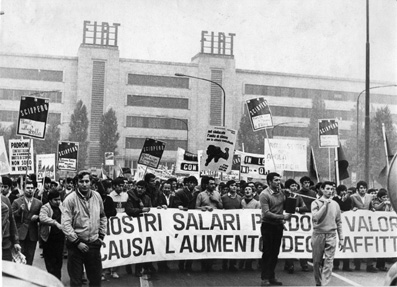 |
Peoples' movements and protests |
 |
|
Mobilizations16-17 century piracyThe slave uprising in HaitiThe Chartists1848The First internationalThe Social Democratic PartyThe Revolutions 1917-19General strike in Hong Kong 1925-26The occupation of FlintThe welfare statePeronismThe boom of the 60s-70s in EuropeSolidarnoscThe metal strike in São PauloThe Hyundai strikeBack to Labour MovementsBack to main page |
The resurgence of the labor movement in Europe in the 60s and 70s
By 1965, the Fordist production technology had made a serious impact in Europe. Strike became easier. And at the same time, the success of the anti-colonial movements and the peasant mobilizations they inspired had pushed the world’s rulers backwards and made them look weak. Europe's workers began to find it worthwhile to mobilize for long-term goals again. A first breakthrough was made in France in 1968, inspired by the youth uprising there the same year. But it was in Italy that the labor movement went furthest. It has to do with the fact that it had been so poorly developed before. No extensive trade union bureaucracy had developed that could link the movement to dead ends. The driving force in the Italian labor movement was the workers of the young first generation in the metal industry. They developed forms of warfare that would be used throughout Europe, although they never went as far as in Italy. Strikes were short and small but carried out in strategic places. Factories were occupied and managers were taken hostage. In service companies, employees ignored charging customers instead of striking. The demands concerned as much power over the work process as higher wages, and the wage demands concerned as much equalization as increase. Demands were implemented in a tangible way without caring about signing contracts: working hours were shortened, overtime was abolished. At Fiat and Olivetti, company management recognized the workers’ right to self-determination, working hours and the right to refuse dangerous work. At the same time, the unions were politicized while the power of the parties diminished. The union made demands for social housing construction, lower tariffs and regional policy. Across Europe, workers’ power was strengthened and states were forced to implement democratic reforms. After 1975, the business community hit back, mainly by locating work processes to peripheral countries – where the labor movements were consequently strengthened. But in Europe (and the United States) the labor movements were as severely confused as when the wave of mobilization in 1916-19 receded. Reading
|
